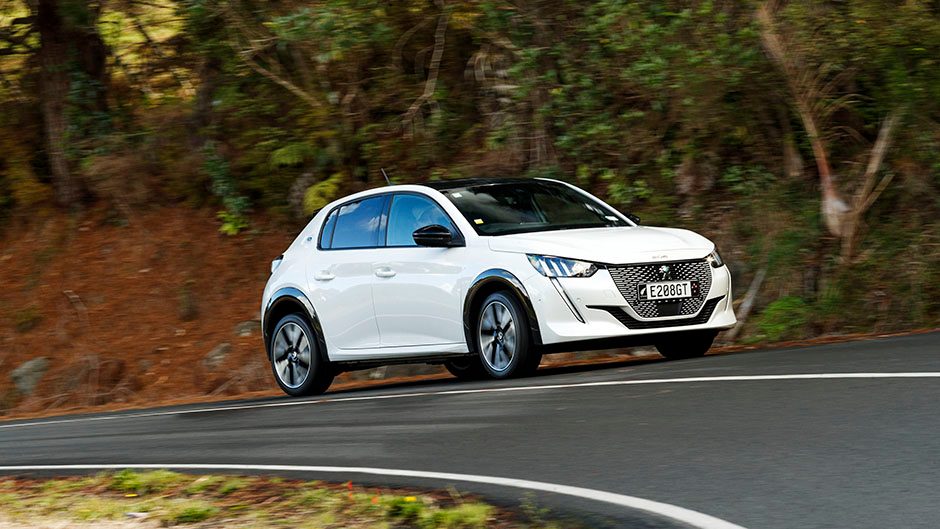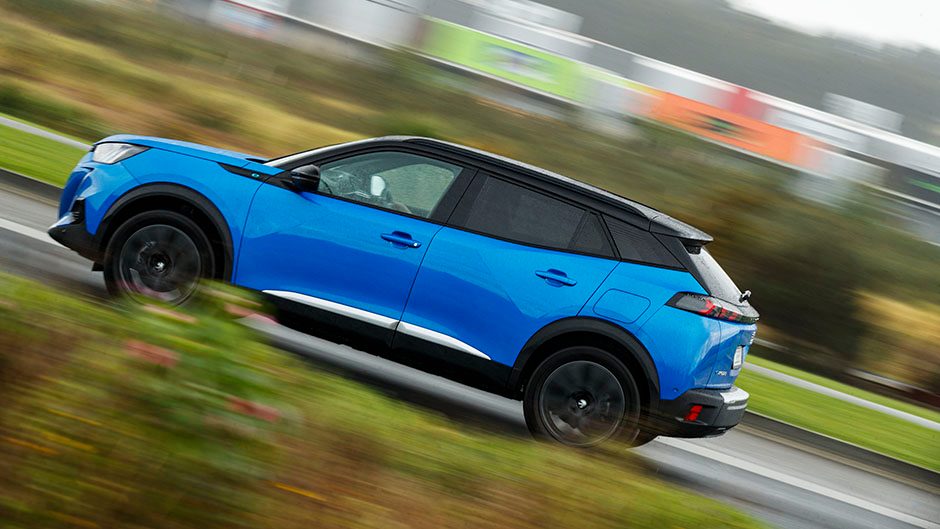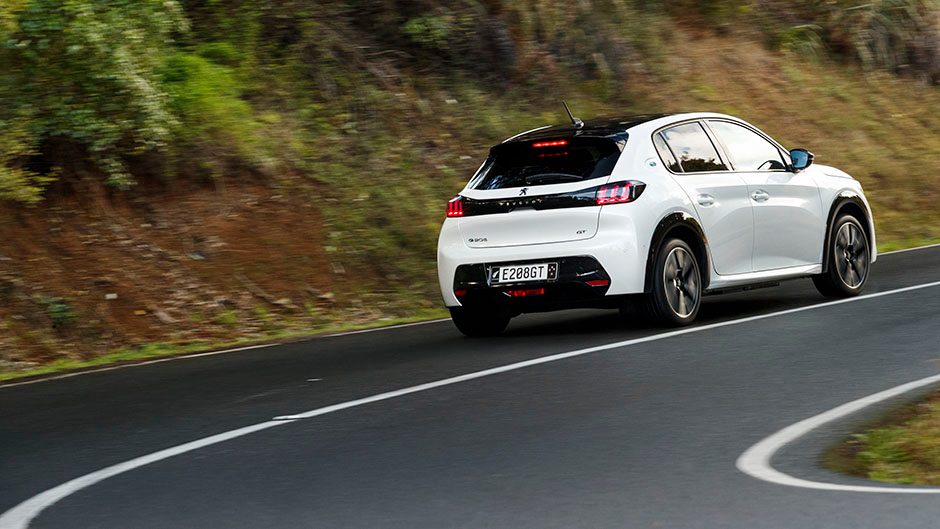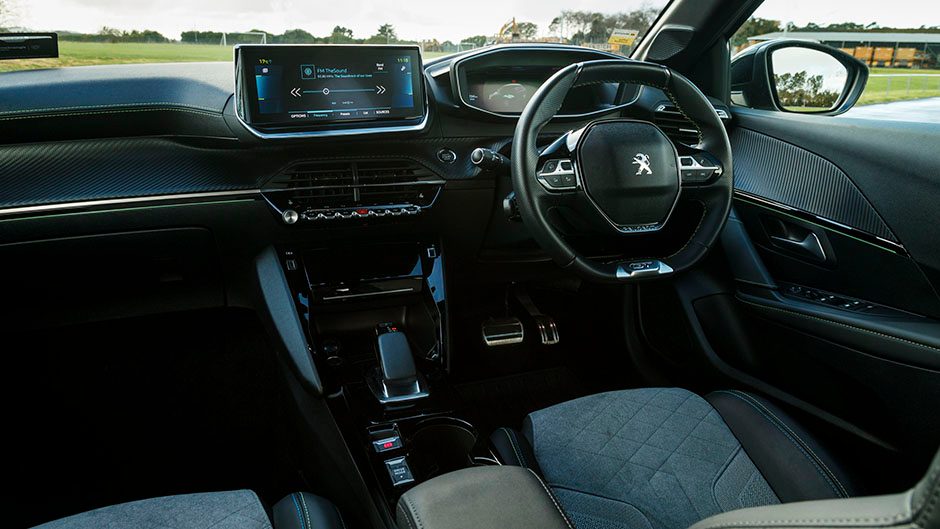Peugeot is embracing the electric revolution, with a plan to have a volted option in all model lines by 2025. And that’ll be true of the line-up here too, with a mixture of PHEV and BEVs. We’ve seen the 3008 PHEV already (good but pricey) while the first of the full BEVs will be arriving soon in the e-208 and e-2008.
Better get the nasty details out of the way first with pricing. The e-208 is $59,990 (the regular 208 GT is $37,990) but the e gets the $8625 Clean Car rebate. The e-2008 is ten kay extra (also eligible for the cash back), the premium that these ‘must have’ compact SUVs command.

These two sit on the firm’s new CMP (Common Modular Platform) underpinnings and its key design brief was to be ‘multi-energy’, accommodating both ICE/fuel tanks and motor/battery powertrains.
The CMP is lighter than the firm’s previous small car chassis, more aerodynamic with a flat undertray, has ‘reduced suspension friction’ for added efficiency and improved NVH (important for EV applications) while the upgraded electrical architecture supports all the usual active safety features.
Both e models use the same powertrain with a 100kW motor producing 260Nm mated to a 50kWh lithium-ion battery that lives under the floor and rear seat. As such, the interior and boot-space are identical to the conventional versions. As to range, the e-208 has up to 340km, according to the WLTP, e-2008 320km. As always yours will vary as to where, when and how you drive.

We had a brief introduction to both, Peugeot NZ landing a pair of evaluation units prior to customer cars arriving later this month, with the first allocation of stock already sold (more on that later).
With the 208 we managed an average of 17kWh/100km over a couple of hundred kays, though you’ll likely see between 13kWh/100km (think your drive to work on urban streets in stop/start rush hour) and 20kWh/100km, at a constant 100km/h highway running. The 2008 is much the same. It’s trip computer was configured to relay consumption in the more useful format of km/kWh, giving you a better grasp of how many kays you get per kWh of energy. We took a drive north for the weekend, albeit not that far, to the Mahurangi peninsula, a popular destination for Aucklanders with the wherewithal for EVs. On highways limited to 80km/h (about ideal for EV open road travelling but don’t tell the authorities, they’ll change all the limits to suit), we were surprised to get 6.5km/kWh (15kWh/100km). Like a Hobbit, we got there and back, with some peninsula touring, without the need for a recharge. So the range is good then.
Both ride well, particularly the 208 (for a small car), the damping adapted for the extra weight (the e-208 1508kg, the GT 1186kg). Both have light steering (in both heft and feel), but the improved weight split from the centrally mounted battery gives them a neutral feel through turns, despite carrying extra mass. The 208 is a tad friskier than the SUV, though the brakes are too snatchy in action and the ESP can get excited in tight turning.

There are Eco, Normal and Sport drive modes, the latter amping the delivery to give a jolt more spunk but also more in the way of wheel spin. The twins go alright in Normal, to be fair, with the usual easy pull and smooth progress. In D there’s minimal regen, but the B mode gives more motor resistance for a quasi one-pedal drive mode. They go rather well in the B drive mode at 100km/h on highway, making for a smooth, pleasant drive. There is some mechanical whirring of the drive bits and oddly the brake pedal action was more nuanced in the 2008; the 208 wasn’t particularly great, especially in B mode. Both models have the same dash, screens and Pug’s iCockpit with the 3D digital dials but are otherwise quite conventional. We liked the extra space in the 2008 with more of it everywhere. Along with the extra 250mm length and a longer wheelbase, the added seat height offers extra legroom in all positions. The 208 is a bit confined up front, the boot much smaller too (311 vs 434L). While each has hard, small car plastics about the cabin, they are otherwise rather nice compared with others in the class, miles better than the Zoe for instance. These are flush with safety kit including AEB, lane centring, active cruise, blind spot minders and traffic sign recognition. The ten-inch infotainment screen features nav, Car Play and Android Auto. There’s a smartphone docking station, a heap of USB points and while the seats aren’t powered, they are trimmed well and heated.
A few other specifics, the battery is guaranteed for eight years or 160,000 km for 70 per cent of its charge capacity. Charge times can be scheduled via the touchscreen or the smartphone app so the car will start charging at night to reduce loads in peak times. Peugeot NZ is recommending to customers that the money they save from the rebate should be invested in a wallbox to improve their charging experience. Both cars have a 7.4kW on board charger, and Peugeot NZ might look to offer an available 11.4kW charger as an optional extra for those who need faster AC charging. Charge times ranges from 28 hours with the portable charger to seven hours with the wallbox. With the battery at 35 per cent, a 50kW DC charger raised it to 81 per cent in 30mins, while the range indicator morphed from 82 to 238km. Unfortunately, you won’t be able to haul your boat with either of these as they aren’t rated to tow.

Peugeot NZ sees EVs as a good opportunity for the brand to connect with new customers. And a novel iOWN finance/leasing deal should help boost sales. The deal on the e-208 is $165 a week, which is just $36 more than the regular 208, so you’ll easily recoup that in ‘fuel costs’. It’s a no-deposit deal with guaranteed residuals. There are three options at the end of the lease term including keeping the car by paying the ‘Guaranteed Future Value’, trade it or return it (though the latter is subject to T&Cs). Best head to the website for more information. But if you like the idea of an EV but not the upfront expense, this might be the way to get you moving electrically.
Peugeot is investing 30 billion Euros in EV technology over the next five years with five ‘giga’ factories for EV production coming online around the world. At the moment only one factory in Slovakia is making the e-208 and e-2008 for the world, so supply is somewhat throttled.
Of the 100 production spots for NZ in its initial allocation (all sold by the way), 70 of those are for the 208, though Peugeot expects the split to tilt toward the 2008 long term; it’s a compact SUV afterall, NZ’s favourite type of vehicle, behind utes that is. Order one today, and you’re looking at delivery in January 2022. But then the wait on all Peugeots (and many of its competitors too) is about the same as firms grapple with chip shortages and international shipping issues.
| Model | Peugeot e-208 |
| Price | $59,990 |
| Motor | single, 100kW/260Nm |
| Battery | 50kWh (45kWh net) |
| Drivetrain | single-speed, FWD |
| Energy Use | 16.4kWh/100km |
| C02 Output | 0g/km |
| 0-100km/h | 8.35sec |
| Weight | 1507kg |


